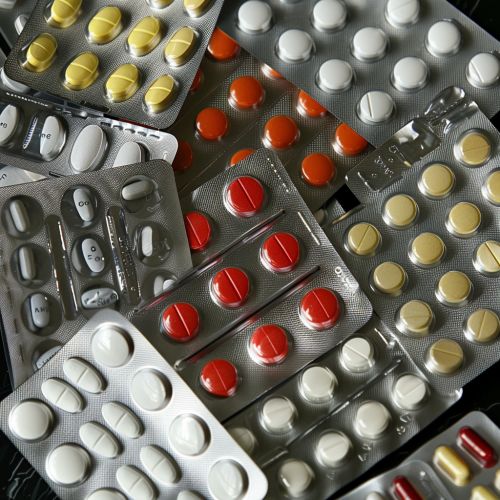Anticoagulant: Difference between revisions
(Created page with "== Introduction == An anticoagulant is a substance that prevents blood coagulation, thereby prolonging the clotting time. Anticoagulants are commonly referred to as blood thinners, although they do not actually thin the blood. They play a crucial role in the management and prevention of thromboembolic disorders, including deep vein thrombosis (DVT), pulmonary embolism (PE), and atrial fibrillation (AF). This article delves into the mechanisms, types, clinical...") |
No edit summary |
||
| Line 59: | Line 59: | ||
Research is ongoing to develop new anticoagulants with improved safety profiles and efficacy. Novel agents targeting different pathways in the coagulation cascade are under investigation. | Research is ongoing to develop new anticoagulants with improved safety profiles and efficacy. Novel agents targeting different pathways in the coagulation cascade are under investigation. | ||
[[Image:Detail-92479.jpg|thumb|center|A variety of anticoagulant medications in their packaging.|class=only_on_mobile]] | |||
[[Image:Detail-92480.jpg|thumb|center|A variety of anticoagulant medications in their packaging.|class=only_on_desktop]] | |||
== See Also == | == See Also == | ||
Latest revision as of 10:49, 14 June 2024
Introduction
An anticoagulant is a substance that prevents blood coagulation, thereby prolonging the clotting time. Anticoagulants are commonly referred to as blood thinners, although they do not actually thin the blood. They play a crucial role in the management and prevention of thromboembolic disorders, including deep vein thrombosis (DVT), pulmonary embolism (PE), and atrial fibrillation (AF). This article delves into the mechanisms, types, clinical applications, and potential complications associated with anticoagulants.
Mechanisms of Action
Anticoagulants function by interfering with the coagulation cascade, a series of enzymatic reactions that lead to the formation of a blood clot. The coagulation cascade is divided into the intrinsic and extrinsic pathways, which converge on the common pathway. Anticoagulants target various factors within these pathways to inhibit clot formation.
Inhibition of Vitamin K-Dependent Factors
Vitamin K antagonists, such as warfarin, inhibit the synthesis of vitamin K-dependent clotting factors (II, VII, IX, and X) in the liver. By reducing the activity of these factors, warfarin effectively prolongs the clotting time.
Direct Thrombin Inhibitors
Direct thrombin inhibitors, including dabigatran, bind directly to thrombin (factor IIa), preventing the conversion of fibrinogen to fibrin, a crucial step in clot formation.
Factor Xa Inhibitors
Factor Xa inhibitors, such as rivaroxaban and apixaban, selectively inhibit factor Xa, a key enzyme in the common pathway of the coagulation cascade. This inhibition prevents the conversion of prothrombin to thrombin.
Types of Anticoagulants
Anticoagulants can be broadly classified into several categories based on their mechanism of action and route of administration.
Vitamin K Antagonists
Warfarin is the most commonly used vitamin K antagonist. It is administered orally and requires regular monitoring of the International Normalized Ratio (INR) to ensure therapeutic efficacy and minimize the risk of bleeding.
Direct Oral Anticoagulants (DOACs)
DOACs, including dabigatran, rivaroxaban, apixaban, and edoxaban, offer several advantages over traditional vitamin K antagonists. They have predictable pharmacokinetics, do not require routine monitoring, and have fewer dietary restrictions.
Heparins
Heparins are divided into unfractionated heparin (UFH) and low molecular weight heparin (LMWH). UFH is administered intravenously and requires frequent monitoring of the activated partial thromboplastin time (aPTT). LMWH, such as enoxaparin, is administered subcutaneously and has more predictable pharmacokinetics, reducing the need for monitoring.
Direct Thrombin Inhibitors
In addition to dabigatran, other direct thrombin inhibitors include bivalirudin and argatroban, which are primarily used in clinical settings for patients undergoing percutaneous coronary intervention (PCI) or those with heparin-induced thrombocytopenia (HIT).
Clinical Applications
Anticoagulants are used in various clinical scenarios to prevent and treat thromboembolic disorders.
Venous Thromboembolism (VTE)
VTE encompasses both DVT and PE. Anticoagulants are the cornerstone of VTE treatment, aiming to prevent clot extension and recurrence.
Atrial Fibrillation
In patients with AF, anticoagulants reduce the risk of stroke by preventing the formation of thrombi in the atria, which can embolize to the brain.
Mechanical Heart Valves
Patients with mechanical heart valves require lifelong anticoagulation to prevent thromboembolism. Warfarin is the anticoagulant of choice in this population.
Acute Coronary Syndromes (ACS)
In ACS, anticoagulants are used alongside antiplatelet agents to prevent clot propagation and re-occlusion of coronary arteries.
Complications and Management
While anticoagulants are effective in preventing thromboembolic events, they carry a risk of bleeding complications.
Bleeding
Bleeding is the most significant complication of anticoagulant therapy. Management strategies include dose adjustment, temporary discontinuation, and the use of reversal agents.
Reversal Agents
Reversal agents are available for some anticoagulants. Vitamin K and prothrombin complex concentrate (PCC) are used to reverse warfarin. Idarucizumab is a specific reversal agent for dabigatran, while andexanet alfa reverses the effects of factor Xa inhibitors.
Monitoring
Monitoring is essential for certain anticoagulants to ensure therapeutic efficacy and safety. Warfarin requires regular INR monitoring, while UFH necessitates aPTT monitoring.
Future Directions
Research is ongoing to develop new anticoagulants with improved safety profiles and efficacy. Novel agents targeting different pathways in the coagulation cascade are under investigation.


